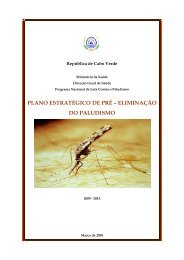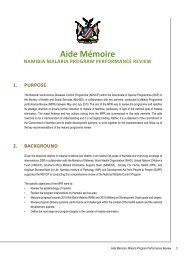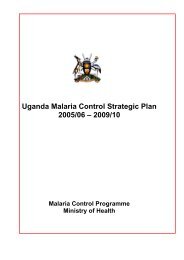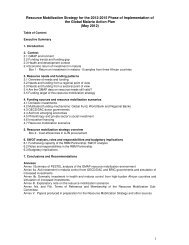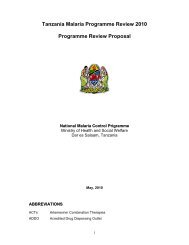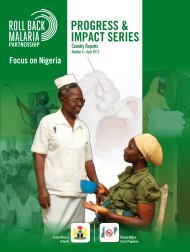Progress & ImPact serIes - Roll Back Malaria - World Health ...
Progress & ImPact serIes - Roll Back Malaria - World Health ...
Progress & ImPact serIes - Roll Back Malaria - World Health ...
Create successful ePaper yourself
Turn your PDF publications into a flip-book with our unique Google optimized e-Paper software.
The Vector-borne Disease Control Programme<br />
(VDCP) of Bhutan coordinates and oversees the<br />
district health teams that execute all prevention<br />
activities related to vector-borne diseases.<br />
Bhutan’s national health system feeds the<br />
VDCP critical information on the availability of<br />
commodities for malaria preventive activities<br />
and the number of cases detected and treated<br />
(26). The information guides malaria service<br />
delivery which is conducted by multipurpose<br />
malaria health workers known as “malaria<br />
technicians” (27) who work exclusively on<br />
malaria-related activities. They support vector<br />
control operations (IRS and LLIN distribution,<br />
entomological surveillance) and are responsible<br />
for undertaking diagnostic testing, providing<br />
malaria treatment, reporting malaria cases, and<br />
following up on case outcomes. The VDCP has<br />
recently begun to integrate malaria technicians<br />
into other vector-borne disease programmes,<br />
subsequently expanding these technicians’ roles<br />
beyond malaria control. So far only a minority of<br />
technicians has begun this integration and the<br />
policy is being monitored to assess whether or<br />
not it will reduce the quality of malaria services<br />
delivered (28).<br />
Indoor residual spraying (IRS) served as the<br />
country’s main vector control method until 1998,<br />
when IRS activities halted and insecticide-treated<br />
nets (ITNs) became the primary vector control<br />
intervention. Starting in 2004, IRS was slowly<br />
re-introduced in areas that exceeded thresholds<br />
for malaria case incidence rates and occurrence<br />
of malaria deaths (28). In 2006, Bhutan began to<br />
distribute long-lasting insecticidal nets (LLINs)<br />
alongside targeted IRS.<br />
The VDCP has addressed the needs of each malaria<br />
species in terms of diagnostic and treatment<br />
services. In 2006, the VDCP started using<br />
bivalent RDTs, which allow for the simultaneous<br />
testing of both P. falciparum and P. vivax with a<br />
single device (28). There are separate treatment<br />
protocols for P. falciparum and P. vivax.<br />
For P. vivax in adults, standard treatment<br />
consists of primaquine for 14 days followed<br />
by 3 days of split chloroquine doses. A 28-day<br />
clinical follow-up to measure medicine adherence<br />
and efficacy in each P. vivax case has been<br />
proposed. For P. falciparum, ACT was introduced<br />
as the first-line drug in 2006, and primaquine<br />
was recommended as a supplementary drug<br />
(as an anti-gametocyte) in 2011. All confirmed<br />
P. falciparum infections in Bhutan require a<br />
three-day compulsory hospital stay to ensure<br />
that patients receive directly observed therapy<br />
of their medications and daily blood slides. upon<br />
discharge, patients are requested to return for<br />
a blood slide examination three days later and a<br />
malaria technician is dispatched to the patients’<br />
home if they fail to return.<br />
Bhutan added malaria as a nationally notifiable<br />
disease in 2010. The country is also planning the<br />
implementation of active case detection (ACD),<br />
to be initiated in 2012. ACD activities will target<br />
high risk populations such as construction sites<br />
and seek to identify imported and asymptomatic<br />
infections and ensure diagnosis and treatment<br />
for all malaria-infected persons.<br />
Several factors have contributed to Bhutan’s<br />
great progress towards eliminating malaria.<br />
<strong>Health</strong> infrastructure is well developed and<br />
substantial funding for its health system is<br />
available through government financing and<br />
donor-backed development grants (29, 30).<br />
Hence, Bhutan has the resources to support an<br />
efficacious national surveillance system and<br />
extensive malaria case management activities.<br />
Bhutan also benefits from a sizeable and reliable<br />
health workforce (31), as well as a highly<br />
functional national supply and logistics system; in<br />
fact, no anti-malarial drug stock-outs have been<br />
recorded in Bhutan in recent years (26). Finally,<br />
Bhutan targets the distribution of LLINs and IRS<br />
to areas at highest risk of malaria, as an efficient<br />
use of commodities and resources. The approach<br />
is likely to be more sustainable for the long-term<br />
goal of malaria elimination than less targeted<br />
distribution of interventions.<br />
DEFEATING MALARIA IN ASIA, THE PACIFIC, AMERICAS, MIDDLE EAST AND EuROPE<br />
43




